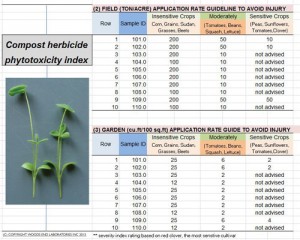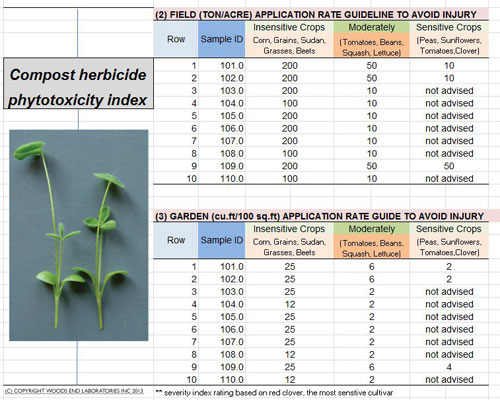
A Risk Injury Table that accompanies each compost report, will guide growers in avoiding potentially risk applications
Composters face certain risks when growers purchase and use products for which herbicide residue effects have not been properly evaluated. The situation has propelled Woods End Labs to upgrade its auxin-injury plant test by adding Risk Categories. The goal is to hybridize plant-injury ranks with compost application rates. “People are being misled into believing that once you have a herbicide residue, the compost is no good,- this is simply not true” says Brinton. The new protocol is based on Woods End’s Compost Matrix, a quality certification system developed for composters that “enables skillful placement into best-use categories” – or, in the case of residues “helps avoid exposing a market segment to undue risk”. Matrix arrays are mathematical devices to sort complex data into simple groups, and appear to work well with plant-injury symptom ranks.
Upgrading the herbicide bioassay to add risk evaluation involved creating plant subcategories: sensitive, affected, and insensitive. It also requires calibrated injury rankings from real bioassays. Wood End first developed the test in 2005 and published several journal articles, including one in Compost Science Utilization (2006- Vol 14:4) , which discussed how bio-assays may be confounded by other anti-quality factors in compost, such as salinity and boron, that interfere with herbicide bioassays. The boron toxicity research was also published in CSU in 2008 (Vol 16:2) since boron caused similar injury in beans that herbicides can. Brinton’s new research will go into a future paper showing the PIRM system working for 4 different auxinic herbicides.
PIRM will show compost application rate thresholds, also called No-Effect Levels (NOELs) that avoid expressing injury symptoms. “In some cases the injury can’t be avoided, so no application rate is considered appropriate”. Brinton reports that several compost companies (PA, UT, VT, ME) are presently using the risk management tool and some have successfully piloted their compost products “out of harm’s way”. Woods End also has developed a means to screen raw source-ingredients before they are even put into composts. “The goal is to move compost and growers from a high-risk to a low-risk category by careful management guided by our matrix bioassays”.

